Wheelworks - Made with Precision
Wheel building is often presented as an art; a creative pursuit that reflects on the hands of the builder. Wheelworks in New Zealand takes a different approach; one that’s shaped heavily by company founder Tristan Thomas.
Now 35, Tristan grew up in Vancouver (Canada) but also spent time in the UK and France before settling in New Zealand in 2001. Despite living in NZ for over a decade, he still considers himself to be Canadian, and that’s where he got into mountain biking. He started riding when he was 12 years old. Modern freeriding was just kicking off; Tristan describes it as “The ‘huck to flat’ and ladder-bridge era.”
“Thankfully some of that stuff has now gone away but the mark that it left on mountain biking is always going to be there—it’s pretty cool I think. Canada was a real hotspot at the time; the trails were really technical, wet, rooty and steep.”
After studying computer science in Canada, Tristan moved to Wellington where he completed a degree in mechanical engineering. All awhile he maintained his interest in mountain biking and cycling in general. He worked in bike shops and eventually faced the decision; pursue a well-paid career in engineering or put his talents to use in the bike industry. Well you can guess how that decision went!

With a desire to build better bike wheels, Tristan started Wheelworks back in 2006. Making full use of his engineering knowledge and mathematical skills, Tristan developed a wheel building process that doesn’t cut any corners. Where regular tools proved lacking, he developed better ones. Individual components are selected on quality not price and this usually means sourcing parts from many different suppliers; for example, the nipples may come from Wheelsmith but the spokes are always DT Swiss. Rather than relying on the stock spoke lengths with a ‘she’ll be right’ approach, every spoke is cut to length (accurate to 0.1mm) and new thread is then rolled on—that’s every spoke on every build. There are no off-the-peg wheels either; each wheelset is custom built to suit the buyers’ needs—right down to the custom decals. The attention to detail goes well beyond our normal expectations.
Tristan is process driven and very pragmatic, so we took the opportunity to pick his brains about all things wheel related; from the Wheelworks build process to wheel design in general.

MBA. What’s it like living and riding in Wellington?
TT. We don’t have a bike park with one big trail network, instead Wellington has three or four different locations scattered around the city, each with very unique pockets of riding.
One area is Rotorua style with pine trees and hardpack dirt. Other spots are more ‘Sydney-like’ with exposed rock and some harder jagged stuff as well. It’s really neat as you can pick and choose depending on the weather and the sort of riding that you want to do.
It’s all close at hand and close to pubs, coffee shop and the beach too—we’re in Lyall Bay and it’s literally 30 metres from the beach—we’re really lucky!
MBA. When you started your own business, why did you choose to focus on wheels?
TT. I’d worked in bike shops for a long time and really enjoyed wheel building. I have always been fascinated by the impact that a good set of wheels can have. Fitting the wrong wheels can turn a good bike into a pretty average one. Of course a nice set of wheels can turn an average bike into a really great one.
I also like the process behind building good wheels. It’s not an art as some people suggest, it is a process and there are a lot of steps involved. Wheel building is all about consistency and accuracy; two things that I enjoy and excel at.
In establishing Wheelworks, I was able to focus on developing the wheel building process, designing tools that assist with each step of the process and create a system that results in extremely consistent high quality wheels. It was something that I found fascination and that I was really into.
MBA. Was there a point where things really took off?
TT. There hasn’t been any single key event; it has just been ongoing word of mouth. We build great wheels and deliver really good customer service. People tell their friends and the business has grown from there.
MBA. How many people do you employ?
TT. There are four of us working full-time at the moment. We have two guys building wheels, one full-time on customer service and I do a mix of customer service as well as stock ordering and business management. We’ve also got a part time graphic designer and a part time accountant.
MBA. How busy is the workshop?
TT. Like every business it goes up and down. It’s extremely rare that we’re quiet and generally ranges between flat-out and busy.
MBA. Does everybody at Wheelworks ride?
TT. Yeah for sure. That’s definitely a key to who we are; we need to have cyclists employed.
MBA. What makes your wheels unique?
TT. We offer a lifetime guarantee on the build quality of all of our wheels.
There are two ways that you can offer that kind of warranty. You can buy something cheaply and sell it for a high price, then replace the ones that fail using the margin that you made. The alternate approach is to put a huge amount of effort into reducing potential problems, using really high quality components with a major focus on quality control, systems and processes. It may sound boring but the end result is a really consistent, good quality pair of wheels—we chose to go that way.
This approach means it takes much longer to build a set of wheels but the end result speaks for itself. To the best of my knowledge were the only company in the world that offers a lifetime guarantee on wheels and our return rate is infinitesimally small—next to zero.
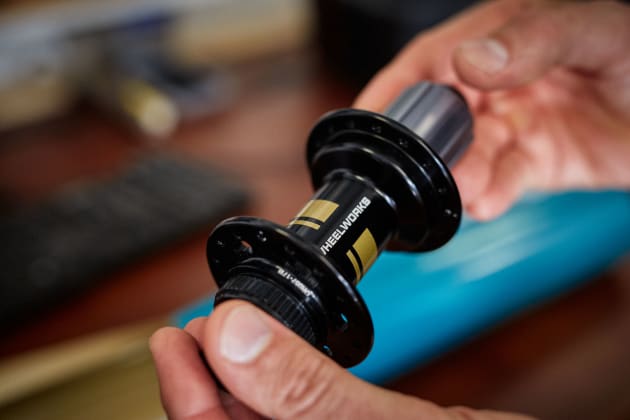
MBA. So how long does it take to build a set of wheels?
TT. From picking the individual components, creating the decals, lacing, truing, tensioning, taking the photos and boxing, it takes around four hours per pair to get them by the front door and ready for pickup. We could cut this in half quite easily if we wanted to but we’d have to compromise on quality or personalisation options, and that’s something that I’m not interested in doing—there’s plenty of people who can do that and I don’t want to be one of them. We want to offer the lifetime guarantee and offer the personalisation options that we’ve got.
MBA. What systems and tools are key to the Wheelworks build process?
TT. There’s no one silver bullet, no one thing that we do that nobody else does that instantly creates a high quality wheelset. It’s more that we look closely at each step within the wheel building process to ensure that every aspect is done in the best possible way and ensuring that it’s repeatable and consistent every single time.
Our two wheel builders are both creatures of habit and extremely fastidious, meticulous people. They’re also very patient with massive attention to detail—they’re really not your normal human beings. Those qualities make for an absolutely great wheel builder.
Most of the tooling is custom made and developed by us. Before the wheels are built, we’ve got some custom software to record all the details for each personalised wheelset. We’ve then got software that’s used to create the decals and they’re CNC cut out from there.
For every wheel we then measure the hubs and rims with custom tools that were designed and developed here. Even within the same brand and model components, there can be small variance in things like the ERD and we take these into account.
We then have some custom software for calculating the spoke length and this takes into account things like spoke stretch under tension. With the drive-side on the rear wheel, each spoke is under around 130kg of tension, so each spoke will grow by about a millimetre under that tension and we take that into account.
Each spoke is then cut to the exact length that’s required – within 0.1mm tolerance – and we roll new thread on using a Japanese-made Morizumi spoke rolling tool. The software also records the exact details for each and every build; spoke length, what grease was used, what prep-steps were done and so on. This way, if we ever had a problem later on or if the owner needed to replace a spoke after having a stick through the wheel, we’ll have all the details on file.
We lace the wheels in a custom built cart that holds everything nice and steady and flat—we’re not building with a wheel leant up against a bench or resting in our lap. The nipples are then set with a custom depth-setting tool to get the threads even and provide a consistent starting point before any tension is added. From there we move onto some German made truing stands. They’re an off-the-shelf item but we’ve heavily customised them to better fit our needs.
Then we’ve got ‘Grimlock’; this is a pneumatic ram that pushes down on the hub to pre-stress a wheel. It’s something that we built and developed and we have dies to suit all different hubs. Grimlock stresses a wheel far beyond what a rider could ever do. We use Grimlock, then re-tension and re-true, then use Grimlock again until the wheel remains straight and holds its tension throughout the process. As a result, there’s no settling or pinging when the wheel is brand new and our wheels will remain true and well tensioned for their natural life.
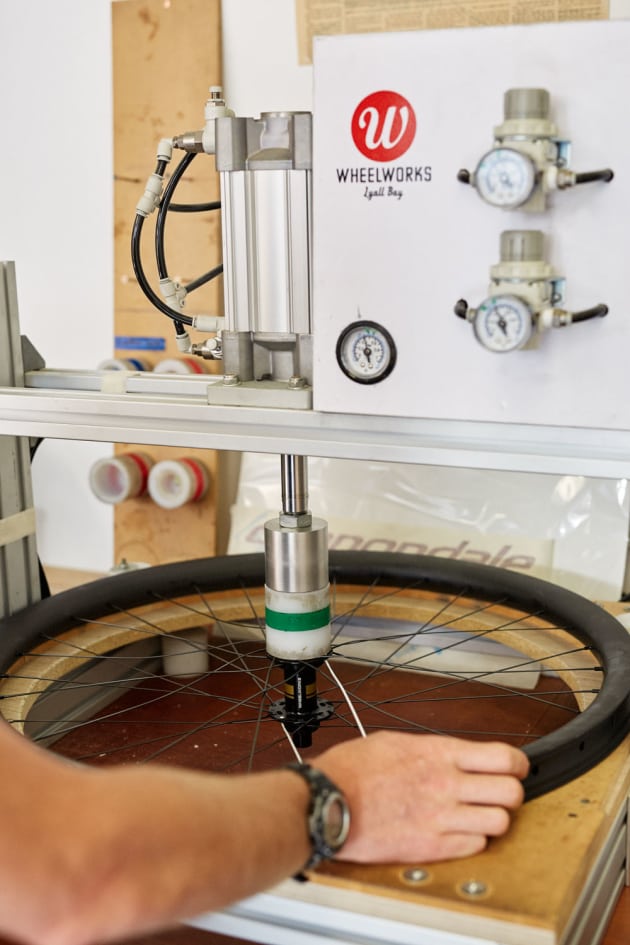
MBA. How much force does it apply to the side of the hub?
TT. Well I can’t tell you that because it’s taken a huge amount of maths, experience and trial and error to get to the number that we’ve settled on.
MBA. So this stress doesn’t push things too far and reduce the lifespan in any way?
TT. No, not with the high quality components that we use. It’s well within the safe limits for our DT Swiss spokes and high quality rims but the forces are still a lot higher than what a rider could produce. That said, we have put other wheels through Grimlock which lead to broken spokes and pulled nipples through rims.
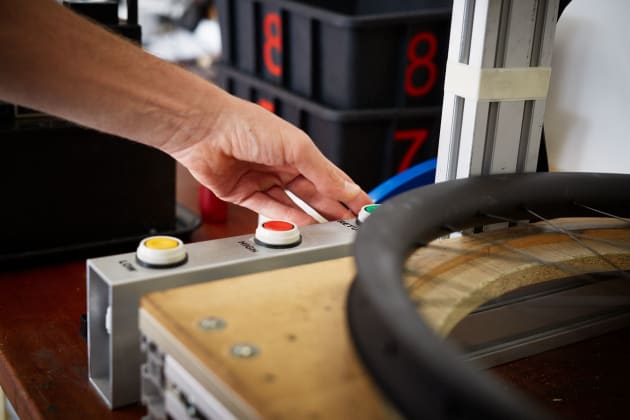
MBA. Who’s responsible the design of all these specialist tools and the software?
TT. I wrote all the software. I know how to code so everything was written by myself using various APIs; we use a lot of Python and Google Apps script too.
My background in mechanical engineering and product design means I’ve spent a lot of time in the workshop welding and working with lathes and mills. This has been invaluable with creating some of the one-off tools that we use to maintain consistency in our build process.
MBA. We often spruik the benefits of wide rims in regards to tyre support, burp resistance and the ability to run lower tyre pressures but do you see any negatives to going wide rims if you’re running regular-width tyres?
TT. I think you have to match your tyre to the rim width. It has taken a while but the industry is finally settling on rim and tyre widths that go together.
Running a 45mm wide rim with a 2.1 inch tyre is going to lead to a poor result; you’ll get a super squared-off tyre that blows past the side knobs really quickly and doesn’t corner very well. At the other end of the scale, running a 2.4 inch or a big plus tyre with an old 19-21mm rim isn’t going to work either; the tyre will wobble around and offer no sidewall support.
So long as the tyre and rim are reasonably well matched, there’s no disadvantage at all to going with a wide rim.

MBA. If you’re a cross-country rider who runs relatively narrow 2.1 inch tyres, what sort of rim width would you consider to be optimal?
TT. I’d say 24-28mm internal would work well with a 2.1 inch tyre. Although most XC racers here are running 2.2 or 2.35 tyres, even for relatively smooth tracks like Rotorua.
For the 2.25 XC/trail widths that we’re seeing more of these days, I’d be suggesting a 30mm internal width for the rim.
MBA. Some suggest that going to a wider rim creates a poor tyre profile. Is this something that you’ve encountered?
TT. I’d say that certain tyre models are prone to this. It seems to relate to the side knobs and the angle that they leave the casing. In some cases, mainly where the tyre knobs really stand up on the casing, fitting them to a wider rim can create an overly squared-off profile.
Still, I think that most brands these days are now designing their tyres around modern rim widths. Even if they don’t claim to be ‘wide specific’, they’re no longer basing everything around the 19mm internal standard from 1994.
MBA. Wide rims allow you to run much lower tyre pressures but this can increase the risk of impact damage in rocky terrain. Is there a point where there’s little to gain from added rim width as you can’t reduce the tyre pressure any further due to the risk of impact damage?
TT. I think that does occur. Look at the World Cup DH guys for example; initially you’d think they’d need as much traction as they can get. You’d expect that wide tyres on wide rims at low pressure would be the go, but the opposite is really the case. You’ll find they often run narrower tyres than an EWS racer with narrower rims and at higher tyre pressures.
Still, I think the downsides to running a wider rim are very minimal. People also need to be realistic about their riding abilities and realise that they’re not Ritchie Rude! Most riders don’t hit things with the speed of a pro downhiller or an EWS racer. You only have to watch those guys ride over a trail that you’re familiar with; the lines they take and the speed they hold is entirely different.
They push their equipment far beyond what even a really talented local rider is capable of, so what works for the pros isn’t necessarily best for the majority. Wide rims will allow most riders to run low pressures for improved traction and comfort without suffering excessive tyre squirm or damage from rock impacts.
MBA. How low is too low when it comes to tyre pressure?
TT. The bead retention on modern rims and tyres has improved a lot, so you can go very low without burping or rolling tyres. You don’t want to go so low that you’re impacting the rim. Obviously there’s a risk of damaging the rim if you hit it hard enough. It’s also an indicator that the tyre has used 100% of its suspension; it’s not capable of deforming any more so you’re giving away traction. You don’t want to be bottoming the tyre on the rim with any regularity.
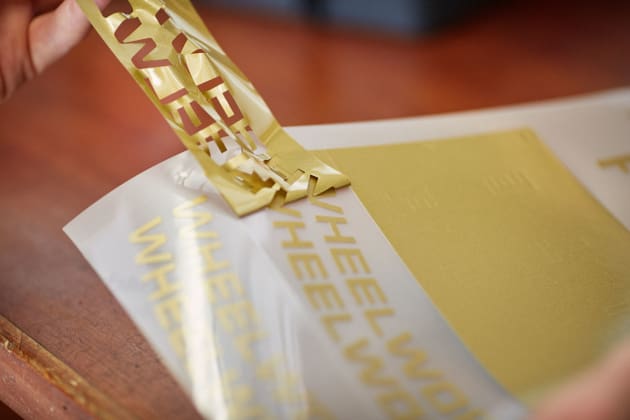
MBA. Until recently your Flite XC wheels used a 29mm internal rim width but your latest offering measures 24mm internally. Did you change to create a lighter wheel option for racers or were there other reasons behind the move?
TT. There were two factors behind this change. We did want to create a lighter rim and we also had cross-country racers chasing a narrower option—24mm rims are still common in the XC market. Some racers get the whole wide rim thing and we still offer a 29 or 30mm rim for XC use. For those that don’t, we wanted to be able to offer a lighter more traditional setup that’s slightly wider than the typical 19-21mm XC rims.
MBA. Would you say the XC market is a bit conservative and slow on the uptake with wide rims?
TT. The cross-country market is very conservative in a many regards, and rim width is one of them. We know that wide rims offer a range of advantages but many racers just want the lightest offering that they can lay their hands on.
MBA. What about hookless rims; do you feel there’s any need for a bead hook to assist with tyre retention?
TT. The only reason for a hook on a rim is if you need to run high tyre pressures. A good example is our Maker AR; it’s a tubeless ready cyclocross rim that’s also suitable for road tyres and you can pump it up to 80psi. If you want one set of wheels that can be used off-road but also handle higher pressures with road tyres, then you need to have a hooked bead.
Other than that there’s no need for a hook—it’s something that was designed in the 1800s and it doesn’t need to be there.
MBA. We hear a lot about stiff wheels being good. Do you feel this is always the case or can too much stiffness be detrimental?
TT. I feel that it’s best to have a perfectly stiff rim. You want to have really good lateral stiffness to support the side loading that occurs when cornering. It also needs to be super stiff to support the tyre; the tyre can then do the flexing and traction finding.
A wheel just can’t flex any significant amount vertically. Even if a rim is designed to have some vertical flex, you’re going to be talking about fractions of a millimetre where as your tyre may have around 50mm of ‘give’ to absorb trail impacts. Why would you compromise tyre support and structural integrity with rim flex when there’s already 50mm of travel in the tyre?
In my opinion a wheel can’t be too stiff, you’ll just be adding unnecessary weight at some point. That’s why I feel modern carbon rims are far better than flexy old aluminium rims.
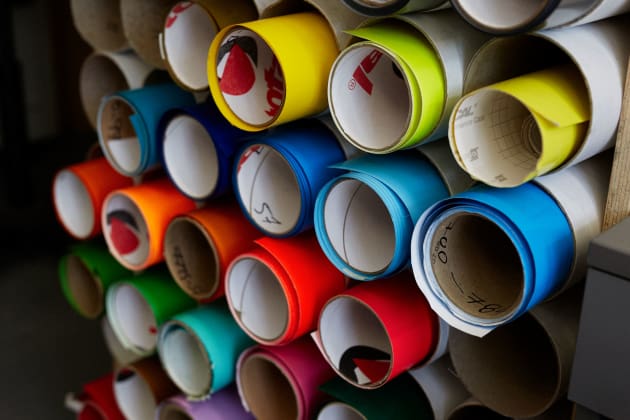
MBA. Previously you’ve used rims from another supplier but for 2017 you’ve moved to your own-brand rims. Why did you swap?
TT. Yes, we used to build with Derby wide carbon rims but now we’ve designed our own using a manufacturer that has lots of experience making very good MTB rims. They know what materials and resins work well in different situations and we’re able to outline how the rim should look; how wide it needs to be, the shape of the bead seat and so on. From there we discuss the materials and resins and put something together that meets our needs.
As to the reasons why we went down this path; it really allowed us to gain control. We now have complete control over the design and development, and we also have complete control over the supply. It’s important that we don’t have to rely on someone else for this sort of stuff.
It also helps when it comes to upholding our warranty. We don’t need send photos to some US company and ask for approval; we now have the ability to approve a warranty ourselves—we can just get on with the job and fix it up.
So it’s all about maintaining complete control; everything from the design to manufacturing and supply as well as the branding and how it looks.
MBA. How did you go about selecting the right carbon supplier?
TT. It was by recommendation from the Taiwanese based manufacturer of our road rims. They pointed us towards a company on mainland China that specialises in mountain bike rims. Our road rim manufacturer really has been exceptional to work with, so we didn’t have any hesitation with taking their advice.
MBA. In looking for a manufacturing partner, did you find the country of origin had much bearing on the quality?
TT. We’ve seen some US made composites that are just terrible and some Chinese made product that’s beautiful; really well thought out, really well manufactured and very high quality.
You can get crappy products that are made in China and you also get crappy products that come out of the UK, US and Europe. The country of origin has no relevance anymore—it means nothing.

MBA. Tell us a little more about your warranty, what it does and doesn't cover and how it works?
TT. All of our carbon mountain bike wheels have a lifetime guarantee that includes impact damage. We don’t have any heavy legal documents outlining our warranty—we’re a small company and we are pretty flexible with it. It basically boils down to this; we guarantee that nothing weird is going to happen to your wheels until they’re worn out.
Things like worn bearings would not be covered (unless they wore out really quickly), as bearings are a consumable item. Catastrophic crash damage or getting a stick jammed through the spokes won’t be covered either. There's also a stipulation that you need stick to the intended use. We had a case where one particular Australian gentleman bought a set of very light wheels for his cross-country bike, but later mounted them to his gravity bike and raced the EWS and Australian DH Series the on the same wheelset! He didn't have any problems but it illustrates why we need to stipulate the intended use.
Stick to the intended use and we will warranty them for any problems including spoke failure and impact damage. If you're running suitable pressures and you crack a rim through hitting a root on your trail bike, then we would replace the rim. We answer our phones and if anyone has any queries or comments about our warranty, then we’re happy to discuss it.
MBA. Does the impact cover apply to both alloy and carbon rims or only the carbon ones?
TT. It only applies to carbon. For most people and most applications, modern carbon rims are simply better in every single measurable way. The only real disadvantage is that they still cost a lot more.
On a trail or enduro style bike, we view alloy rims as a consumable item; similar to a suspension fork or cassette—they'll last and last for a long time but it's eventually going to wear out. If you ride aggressively, you're going to dent the rear rim and at some point you're going to collect so many dents that it's not going to hold air as tubeless. That doesn't happen with the carbon stuff. It doesn’t dent and generally speaking it doesn’t crack either. It remains perfectly true and functional for its entire life.
If you did manage to crack a carbon rim through impact damage, an aluminium rim of the same width and weight would suffer a huge dent that would probably prevent it holding air. Most of the cracked carbon rims that we've seen can still hold air and you can still ride them home without needing to fit an inner tube.
MBA. If an Aussie Wheelworks customer encountered a problem, what would be the procedure in regards to return and repair?
TT. For a potential warranty, we'd want to see some photos of the problem and then we have a very simple return to base warranty. You pay for the shipping to get the wheel back to us and then we will replace the rim, fit new spoke nipples and restore the decals to match everything up. We then pay for the return shipping. We prioritise any of these builds to ensure the customer is back on the trail as soon as possible.
MBA. How many instances of carbon rim damage do you typically see?
TT. Over the past year we've probably had less than 10 claims and that's from many hundreds of pairs of wheels—it's a very low return rate and one that I'd consider as acceptable given the stresses that MTB wheels endure.
MBA. You use DT Swiss Aerolite spokes for most builds. Why use such a light spoke and are there instances where you’d employ a different spoke?
TT. Yeah for sure and we do use a variety of spokes and different spoke counts depending on the customer and what the wheel is being used for, although we do use DT Swiss spokes exclusively. They may cost more but we’ve found they’re more consistent in their quality; we see almost zero failures with them. We may see one unexplained broken spoke a year but the rate was higher when we used other brands.
The Aerolite is the most expensive spoke that DT makes but it’s also the most versatile. Because of that, around 90% of our wheels end up using them. If we do opt for a different spoke, the reason is usually cost related. In those cases we’ll go with a round section spoke like the DT Competition or Revolution. The Aerolite mightn’t be the stiffest spoke but it is the most durable that DT makes. Modern rims are far stiffer than they ever used to be, so we can get away with using a very light spokes like the Aerolite without it impacting on the overall wheel stiffness. These spokes also save around 150 grams over the wheelset, which is huge. If you’re spending big money on carbon rims, it doesn’t make sense to then give away 150g of weight in the spokes.
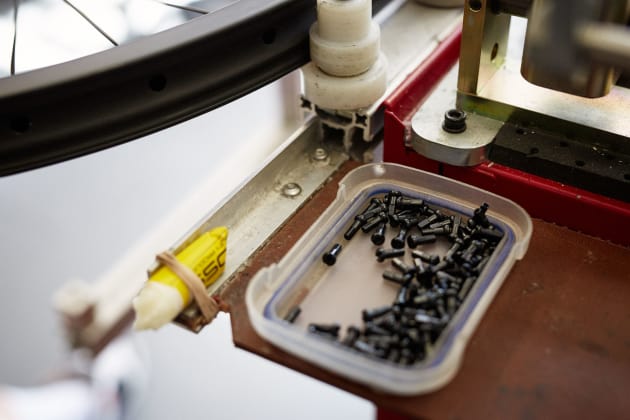
MBA. You also use alloy nipples on most of your wheels; how do they fare in regards to longevity and corrosion resistance in carbon wheels?
TT. There will be times when we use chrome plated brass but it’s pretty rare. We probably use anodised alloy in 95-99% of all our builds. Aluminium does have a little bit of a bad reputation but we offer a lifetime warranty on our alloy nipples. We’ve got a number of steps with preparing the spokes and the nipples to ensure that they don’t seize and don’t break. Here in Wellington it’s super wet but we still don’t see any corrosion problems due to the way we treat our nipples and build our wheels.
MBA. What advantage do you see with using alloy nipples over brass?
TT. They save around 40g on a pair of wheels but looks also come into it. On a high-end build with black spokes and carbon rims, it just grinds my gears to fit silver nipples—it looks far better in all-black. You can get black coloured brass nipples but these always fade to a horrible grey before turning silver.
MBA. What’s the most satisfying experience you’ve had since establishing Wheelworks?
TT. Having customers come to us because one of their friend’s wheels are so good and they had such a great buying experience that they couldn’t stop raving about us. It gives me a huge amount of pride to run a business that people love enough to recommend to their friends.











